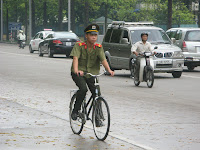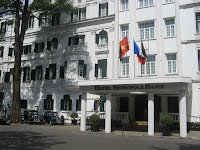We flew to Hanoi for four days to celebrate our wedding anniversary. Hanoi is the capital of Vietnam and has a population of over 6 million people. Hanoi is Vietnam's second largest city and it is situated in the northern part of the country (Vietnam is a very long-shaped country and is bordered by China, Laos and Cambodia). Vietnam is officially known as the Socialist Republic of Vietnam and is a single party state. We spent two days in Hanoi and two days in Halong Bay (a lovely and peaceful excursion away from the busy city). While in Hanoi we stayed at the Intercontinental Hanoi Westlake Hotel, which was a tranquil sanctuary away from the busy, noisy and often chaotic streets of Hanoi.
The Old Quarter
This area has more than 1000 years of history behind it and today is an interesting blend of past and present. This area is known for its densely packed lanes, congested streets and tube houses (Long and narrow buildings with a shop that opens to the street and private living quarters to the rear and upstairs. These tube houses were built on slim lots to cheat an ancient system that calculated property taxes in proportion to a property's width).
We spent an afternoon exploring this interesting area, although it wasn't the easiest area to walk around. Walking in this area is especially challenging because of the small congested streets and pavements, the large number of people and chaotic traffic moving in all directions. The pavements in this area are narrow and many times filled with street vendors and motorcycles, which meant that we had to walk in the streets. We found traffic in the Old Quarter to be very chaotic - surprisingly we didn't see any accidents! Motorcycles are the common mode of transport and they are everywhere. Crossing the streets as pedestrians, while trying to avoid being hit by one (or more) of these motorcycles was stressful - although again, we didn't see any accident casualties. The hint we got from the driver who took us to Halong Bay, was to just walk cross the streets slowly and the people on the motorcycles would maneuver around us ! Not very reassuring, but that is how we managed as pedestrians in this busy part of the city. We also found the noise levels in Hanoi to be extremely high (reminded us a lot of Kathmandu), with the sound of horns everywhere. Unlike in most Western countries, where honking one's horn can be perceived as being rude or only used as an alert, here in Hanoi it is a way of life.
After walking around for a few hours in the heat and visiting numerous galleries, silk shops and markets (it was very hot - around 36 degrees), we decided to stop for refreshments at a nice little cafe at one of the busiest intersections of the Old Quarter. It was mesmerizing to watch the swarms of motorcycles passing by and people going about with their daily lives.




















The French Quarter
We spent an enjoyable afternoon exploring The French Quarter. The French took control of Hanoi in 1882 and created this district for bureaucrats and traders. The appeal of this area is in the colonial architecture, from the beautiful Opera House and Hanoi's legendary Metropole Hotel, to government buildings and lovely villas. Like the Old Quarter, this area has its fair share of food vendors, shops and motorcycles, but unlike the Old Quarter it felt less congested. We had a great time looking at some of the beautiful architecture, walking along the pretty tree-lined boulevards and visiting numerous galleries.
We spent an enjoyable afternoon exploring The French Quarter. The French took control of Hanoi in 1882 and created this district for bureaucrats and traders. The appeal of this area is in the colonial architecture, from the beautiful Opera House and Hanoi's legendary Metropole Hotel, to government buildings and lovely villas. Like the Old Quarter, this area has its fair share of food vendors, shops and motorcycles, but unlike the Old Quarter it felt less congested. We had a great time looking at some of the beautiful architecture, walking along the pretty tree-lined boulevards and visiting numerous galleries.








Ho Chi Minh
Ho Chi Minh, the Vietnamese Communist leader who was both prime minister and president of North Vietnam, is a revered national hero. To this day, thousands of Vietnamese make the pilgrimage to Hanoi to see Bac Ho (Uncle Ho) as he is known. Like other communist leaders (Mao and Lenin), Ho Chi Minh was embalmed after his death in 1969. His body lies eternally in state in an impressive mausoleum, which is open to the public for viewing. The strong presence of military police was everywhere and security around and in the mausoleum was tight. Before entering, we had to go through metal detectors and had to leave our camera at the security check-point (no photographing is allowed inside). Ho Chi Minh's body is in a large glass casket, guarded by 5 military police and the public is permitted to walk around the casket. It was quite surreal to see such a historic figure in the flesh.
Ho Chi Minh, the Vietnamese Communist leader who was both prime minister and president of North Vietnam, is a revered national hero. To this day, thousands of Vietnamese make the pilgrimage to Hanoi to see Bac Ho (Uncle Ho) as he is known. Like other communist leaders (Mao and Lenin), Ho Chi Minh was embalmed after his death in 1969. His body lies eternally in state in an impressive mausoleum, which is open to the public for viewing. The strong presence of military police was everywhere and security around and in the mausoleum was tight. Before entering, we had to go through metal detectors and had to leave our camera at the security check-point (no photographing is allowed inside). Ho Chi Minh's body is in a large glass casket, guarded by 5 military police and the public is permitted to walk around the casket. It was quite surreal to see such a historic figure in the flesh.






Presidential Palace
The Presidential Palace was home to the governor general of French Indochina and was built in 1906. Members of the public can purchase tickets to visit the grounds of the Presidential Palace and Ho Chi Minh's stilt house (which is what we did), but unfortunately the inside of the Presidential Palace is not open to the public. The grounds and gardens around the palace were impressive.
The Presidential Palace was home to the governor general of French Indochina and was built in 1906. Members of the public can purchase tickets to visit the grounds of the Presidential Palace and Ho Chi Minh's stilt house (which is what we did), but unfortunately the inside of the Presidential Palace is not open to the public. The grounds and gardens around the palace were impressive.




Ho Chi Minh's Stilt House
We visited Ho Chi Minh's humble stilt house, which is where he worked and lived from 1958 until his death in 1969. It is quite a contrast to the Presidential Palace, which is situated on the same grounds. This stilt house symbolises Ho Chi Minh's simple and modest way of life.
We visited Ho Chi Minh's humble stilt house, which is where he worked and lived from 1958 until his death in 1969. It is quite a contrast to the Presidential Palace, which is situated on the same grounds. This stilt house symbolises Ho Chi Minh's simple and modest way of life.





Nha Tho (Hanoi Cathedral)
Also known as St Joseph's Cathedral, this cathedral with its twin arches and Gothic arches has been compared to Paris' Notre Dame Cathedral. This cathedral however, is smaller and greyer and in need of restoration. It nevertheless is a striking piece of architecture in the city of Hanoi.
Also known as St Joseph's Cathedral, this cathedral with its twin arches and Gothic arches has been compared to Paris' Notre Dame Cathedral. This cathedral however, is smaller and greyer and in need of restoration. It nevertheless is a striking piece of architecture in the city of Hanoi.


Ngoc Son Temple
This island-temple is situated at the northern end of Hoan Kiem Lake. Hoan Kiem Lake is situated in the heart of Hanoi and is a popular place for locals (especially in the mornings), where many can be found walking around the lake or performing Tai Chi and other exercises. Ngoc Son Temple was founded in the 14th century, with the buildings dating back to the 18th century. The temple is reached via a picturesque footbridge. One of the main sights in the temple is the preserved remains of a giant turtle, measuring 2.1 metres and weighing 250 kilograms, that was captured in the Hoan Kiem Lake in 1968.
This island-temple is situated at the northern end of Hoan Kiem Lake. Hoan Kiem Lake is situated in the heart of Hanoi and is a popular place for locals (especially in the mornings), where many can be found walking around the lake or performing Tai Chi and other exercises. Ngoc Son Temple was founded in the 14th century, with the buildings dating back to the 18th century. The temple is reached via a picturesque footbridge. One of the main sights in the temple is the preserved remains of a giant turtle, measuring 2.1 metres and weighing 250 kilograms, that was captured in the Hoan Kiem Lake in 1968.








Water Puppets
Water puppetry is a unique Vietnamese form of entertainment that incorporates drama and live music (performed by a traditional Vietnamese orchestra), on a stage that is essentially a large waist-deep pool. This form of entertainment originated in the villages of the Red River Delta and dates back to the 11th century. When the rice fields would flood, the villagers would entertain themselves using this kind of puppetry. The puppets used are made of wood, which are then covered in lacquer. Large rods are used to support the puppets under the water, with the puppeteers controling them from behind a screen. We attended one of the evening shows at the Thang Long Water Puppet Theatre and enjoyed this unique art form.
Water puppetry is a unique Vietnamese form of entertainment that incorporates drama and live music (performed by a traditional Vietnamese orchestra), on a stage that is essentially a large waist-deep pool. This form of entertainment originated in the villages of the Red River Delta and dates back to the 11th century. When the rice fields would flood, the villagers would entertain themselves using this kind of puppetry. The puppets used are made of wood, which are then covered in lacquer. Large rods are used to support the puppets under the water, with the puppeteers controling them from behind a screen. We attended one of the evening shows at the Thang Long Water Puppet Theatre and enjoyed this unique art form.





No comments:
Post a Comment